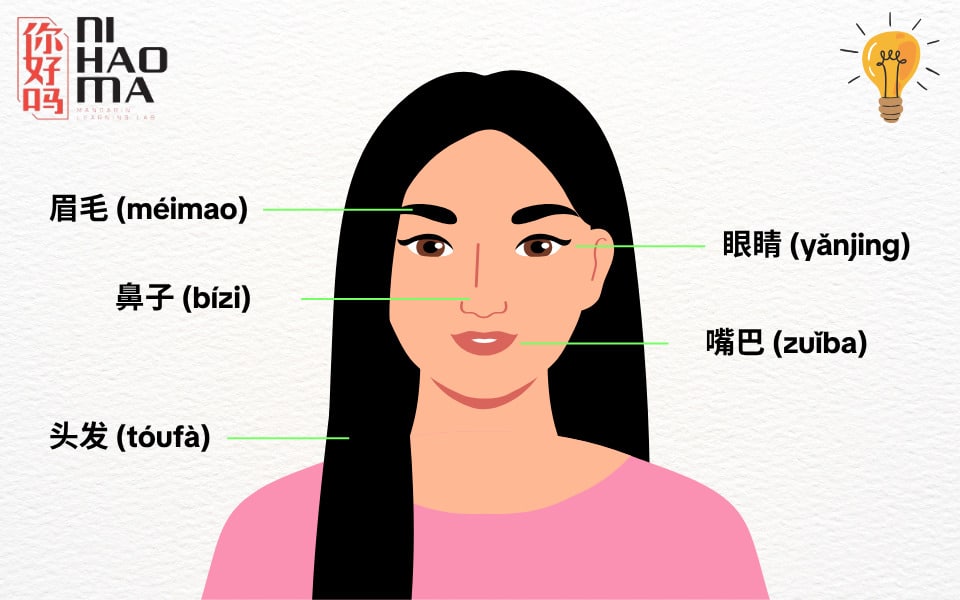When learning Chinese, one of the most fundamental and practical topics is vocabulary related to body parts in Chinese. Whether you’re describing someone, visiting the doctor, or simply engaging in daily conversations, knowing how to refer to human body parts in Chinese can greatly improve your fluency and accuracy.
In this comprehensive guide by Ni Hao Ma, you’ll discover an extensive list of Chinese body parts vocabulary, complete with pinyin, English translations, and practical sentence examples to help you understand and memorize them more easily.
External Body Parts in Chinese
For any Chinese language learner, building a rich vocabulary is always a top priority. And one topic you simply can’t skip is body parts in Chinese. This vocabulary isn’t just helpful in everyday conversations — it’s also incredibly useful when visiting a doctor or simply describing someone.
Let’s explore the vocabulary for human body parts in Chinese together with Ni Hao Ma!
| No. | Chinese | Pinyin | English |
|---|---|---|---|
| 1 | 头 | tóu | Head |
| 2 | 脸 | liǎn | Face |
| 3 | 眼睛 | yǎnjing | Eyes |
| 4 | 鼻子 | bízi | Nose |
| 5 | 嘴巴 | zuǐba | Mouth |
| 6 | 耳朵 | ěrduo | Ears |
| 7 | 眉毛 | méimao | Eyebrows |
| 8 | 睫毛 | jiémáo | Eyelashes |
| 9 | 牙齿 | yáchǐ | Teeth |
| 10 | 舌头 | shétou | Tongue |
| 11 | 脖子 | bózi | Neck |
| 12 | 肩膀 | jiānbǎng | Shoulders |
| 13 | 胳膊 | gēbo | Arms |
| 14 | 手 | shǒu | Hands |
| 15 | 手指 | shǒuzhǐ | Fingers |
| 16 | 指甲 | zhǐjia | Fingernails |
| 17 | 胸部 | xiōngbù | Chest |
| 18 | 背 | bèi | Back |
| 19 | 腰 | yāo | Waist |
| 20 | 肚子 | dùzi | Stomach |
| 21 | 屁股 | pìgu | Buttocks |
| 22 | 腿 | tuǐ | Legs |
| 23 | 大腿 | dàtuǐ | Thighs |
| 24 | 小腿 | xiǎotuǐ | Calves |
| 25 | 膝盖 | xīgài | Knees |
| 26 | 脚 | jiǎo | Feet |
| 27 | 脚趾 | jiǎozhǐ | Toes |
| 28 | 脸颊 | liǎnjiá | Cheeks |
| 29 | 下巴 | xiàba | Chin |
| 30 | 额头 | étóu | Forehead |
| 31 | 皮肤 | pífū | Skin |
| 32 | 脚后跟 | jiǎohòugēn | Heel |
| 33 | 手腕 | shǒuwàn | Wrist |
| 34 | 脚腕 | jiǎowàn | Ankle |
| 35 | 鼻孔 | bíkǒng | Nostril |
| 36 | 头发 | tóufà | Hair |
| 37 | 眼皮 | yǎnpí | Eyelids |
| 38 | 手掌 | shǒuzhǎng | Palm |
| 39 | 嘴唇 | zuǐchún | Lips |
| 40 | 太阳穴 | tàiyángxué | Temple |
| 41 | 腋下 | yèxià | Armpit |
| 42 | 手肘 | shǒuzhǒu | Elbow |
| 43 | 脚底 | jiǎodǐ | Sole (of foot) |
| 44 | 眉心 | méixīn | Between the eyebrows |
| 45 | 喉结 | hóujié | Adam’s apple |

Internal Body Parts in Chinese
What would you do if you had to describe your health condition to a doctor in Chinese? Knowing and correctly using Chinese vocabulary for internal body parts can be a lifesaver, helping you communicate more accurately and effectively in healthcare situations. Let’s explore the essential vocabulary list below!
| No. | Chinese | Pinyin | English |
|---|---|---|---|
| 1 | 脑 | nǎo | Brain |
| 2 | 心脏 | xīnzàng | Heart |
| 3 | 肺 | fèi | Lungs |
| 4 | 肝脏 | gānzàng | Liver |
| 5 | 胃 | wèi | Stomach |
| 6 | 肾脏 | shènzàng | Kidneys |
| 7 | 肠子 | chángzi | Intestines |
| 8 | 小肠 | xiǎocháng | Small intestine |
| 9 | 大肠 | dàcháng | Large intestine |
| 10 | 胰腺 | yíxiàn | Pancreas |
| 11 | 脾脏 | pízàng | Spleen |
| 12 | 食道 | shídào | Esophagus |
| 13 | 喉咙 | hóulóng | Throat |
| 14 | 气管 | qìguǎn | Trachea |
| 15 | 支气管 | zhīqìguǎn | Bronchus |
| 16 | 声带 | shēngdài | Vocal cords |
| 17 | 血管 | xuèguǎn | Blood vessels |
| 18 | 动脉 | dòngmài | Arteries |
| 19 | 静脉 | jìngmài | Veins |
| 20 | 血液 | xuèyè | Blood |
| 21 | 骨头 | gǔtou | Bone |
| 22 | 骨骼 | gǔgé | Skeleton |
| 23 | 关节 | guānjié | Joint |
| 24 | 肌肉 | jīròu | Muscle |
| 25 | 神经 | shénjīng | Nerve |
| 26 | 脊椎 | jǐzhuī | Spine |
| 27 | 脊髓 | jǐsuǐ | Spinal cord |
| 28 | 胆囊 | dǎnnáng | Gallbladder |
| 29 | 软骨 | ruǎngǔ | Cartilage |
| 30 | 子宫 | zǐgōng | Uterus |
| 31 | 卵巢 | luǎncháo | Ovary |
| 32 | 阴道 | yīndào | Vagina |
| 33 | 睾丸 | gāowán | Testicle |
| 34 | 膀胱 | pángguāng | Bladder |
| 35 | 甲状腺 | jiǎzhuàngxiàn | Thyroid gland |
| 36 | 肛门 | gāngmén | Anus |
| 37 | 腱 | jiàn | Tendon |
| 38 | 韧带 | rèndài | Ligament |
| 39 | 淋巴结 | línbājié | Lymph node |
| 40 | 内分泌腺 | nèifēnmìxiàn | Endocrine gland |
The Five Senses in Chinese
| No. | Chinese | Pinyin | English |
|---|---|---|---|
| 1 | 感官 | gǎnguān | Senses |
| 2 | 视觉 | shìjué | Sight |
| 3 | 听觉 | tīngjué | Hearing |
| 4 | 味觉 | wèijué | Taste |
| 5 | 嗅觉 | xiùjué | Smell |
| 6 | 触觉 | chùjué | Touch |
| 7 | 看 | kàn | To see |
| 8 | 听 | tīng | To hear |
| 9 | 尝 | cháng | To taste |
| 10 | 闻 | wén | To smell |
| 11 | 摸 | mō | To touch |
Example Sentences Using Body Parts in Chinese
Learning new vocabulary goes beyond simply memorizing Chinese characters and their pronunciations—what truly matters is knowing how to use them naturally in conversation. To help you master how to talk about body parts in Chinese, we’ve included a variety of practical example sentences below:
Describing Appearance
她有一双大眼睛。
Tā yǒu yī shuāng dà yǎnjing.
She has big eyes.
他的头发很长。
Tā de tóufà hěn cháng.
His hair is very long.
她的鼻子很高挺。
Tā de bízi hěn gāo tǐng.
She has a high-bridged nose.

Expressing Actions or Emotions
他用手指着远方。
Tā yòng shǒu zhǐzhe yuǎnfāng.
He pointed to the distance with his finger.
我用耳朵仔细听。
Wǒ yòng ěrduo zǐxì tīng.
I listened carefully with my ears.
她捂着嘴巴笑了。
Tā wǔzhe zuǐba xiàole.
She laughed while covering her mouth.
Talking About Health or Feelings
我头很疼。
Wǒ tóu hěn téng.
I have a headache.
他的肚子不舒服。
Tā de dùzi bù shūfú.
His stomach feels uncomfortable.
我的腿麻了。
Wǒ de tuǐ mále.
My leg has gone numb.
她感到心脏跳得很快。
Tā gǎndào xīnzàng tiào de hěn kuài.
She felt her heart beating rapidly.
Sample Conversations Using Chinese Vocabulary for Body Parts
In this article, we’ll explore a Chinese dialogue that uses vocabulary related to body parts. It’s a great way to reinforce your knowledge while practicing real-life communication skills. In the conversation below, a patient visits the doctor and describes their symptoms.

A: 你哪里不舒服?
(Nǐ nǎlǐ bù shūfu?)
Where do you feel unwell?
B: 我头很疼,而且喉咙也有点痛。
(Wǒ tóu hěn téng, érqiě hóulóng yě yǒudiǎn tòng.)
I have a bad headache, and my throat is a bit sore too.
A: 你发烧了吗?
(Nǐ fāshāo le ma?)
Do you have a fever?
B: 是的,我的体温是三十八度。
(Shì de, wǒ de tǐwēn shì sānshíbā dù.)
Yes, my temperature is 38 degrees Celsius.
A: 你还有咳嗽或者流鼻涕吗?
(Nǐ hái yǒu késòu huòzhě liú bítì ma?)
Are you also coughing or have a runny nose?
B: 我咳嗽得很厉害,也有点流鼻涕。
(Wǒ késòu de hěn lìhài, yě yǒudiǎn liú bítì.)
I am coughing a lot and also have a bit of a runny nose.
A: 我建议你多休息,喝水,并吃这些药。
(Wǒ jiànyì nǐ duō xiūxi, hē shuǐ, bìng chī zhèxiē yào.)
I suggest you rest more, drink water, and take this medicine.
B: 谢谢医生。
(Xièxiè yīshēng.)
Thank you, doctor.
Final Thoughts
We hope that with the detailed vocabulary lists and clear example sentences provided by Ni Hao Ma, you now have a solid grasp of how to talk about body parts in Chinese. Mastering these words will not only help you accurately describe yourself and others, but also serve as a key foundation for expressing yourself more naturally in Chinese. Keep practicing, and we wish you great success on your journey to mastering Chinese!



